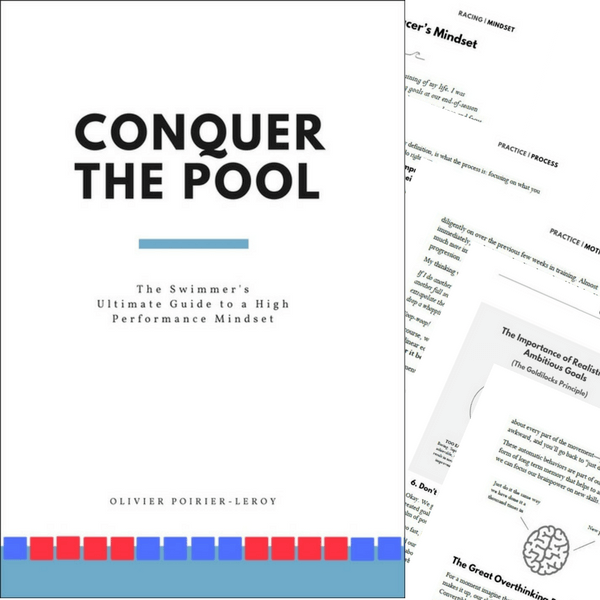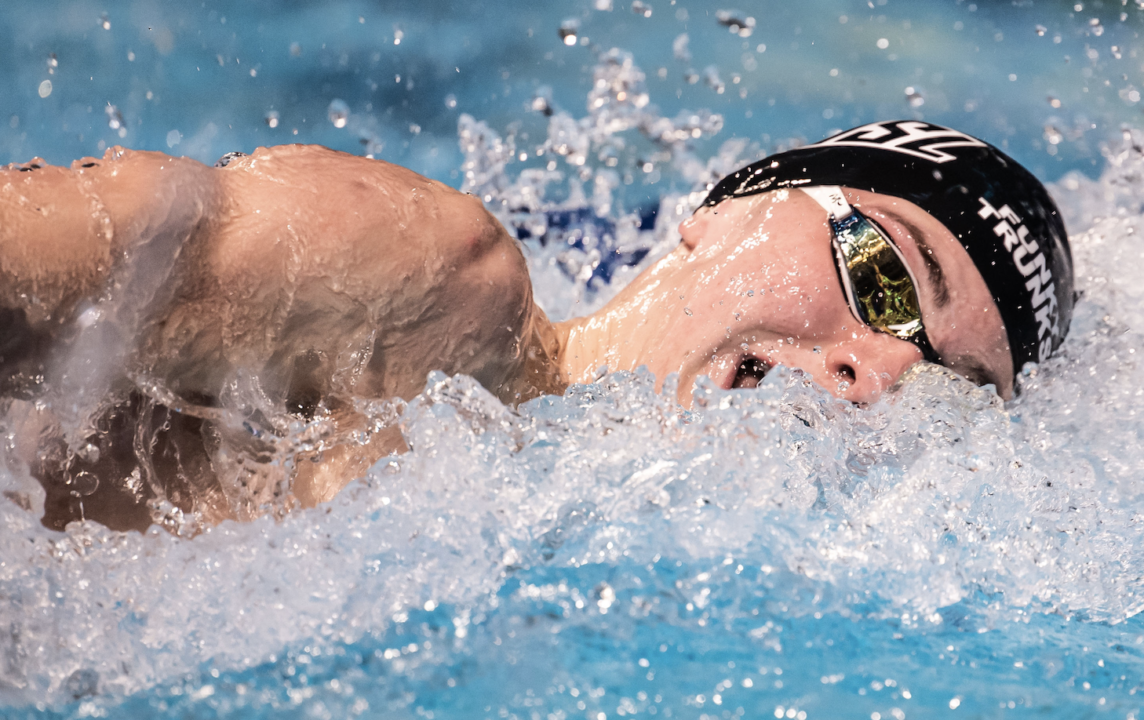Excellent freestyle technique doesn’t just make you look smooth in the water, it shaves time on the clock. Here’s how much of an impact technique can have on race day.
Swimming fast is all about the fundamentals.
Work hard when you are at the pool. Swim with great technique.
When you boil down fast swimming to its simplest components, that’s about it.
That said, reminders to nail the fundamentals each time you dive into the water for swim training are crucial.
After all, how many times have you been told to do something obvious in the water (“Don’t pull on the lane rope!” or “Stop taking your teammates’ kickboard!”) and still kept doing it?
The fundamentals are so obvious that we often pass them over for other shinier aspects of performance, like obsessing over swimsuit fabrics, goggle lenses, or supplements.
Well, here’s your daily reminder to spend more time swimming with killer technique each time you hit the pool.
How Much Swim Technique Affects Performance on Race Day
Let’s get right into the study.
A paper titled “Is Real-Time Poolside Assessment of Upper Limb Errors in Front Crawl Swimming Technique Reliable and Equivalent to Video Analysis?” took a group of 39 elite collegiate swimmers and analyzed their freestyle strokes.
The coaches and researchers assessed the freestyle technique of the 21 women and 18 men, all who had over a decade of competitive swimming experience, using a seven-point checklist of common freestyle technique errors.
Here’s what they looked for when evaluating each swimmer’s technique:
- Arm recovery during the recovery phase. Was the arm excessively bent, creating a finger-drag-type situation in the arm recovery (bad), or was the arm straightish and loose (good)?
- Shoulder roll during the recovery phase. Did swimmers have a flat or excessive shoulder roll (bad) or an optimal degree of rotation in the shoulders (good)?
- Hand orientation during hand entry. At the top of the stroke, when swimmers entered their hand into the water, did the swimmers use their fingertips to pierce the water (good) or did the thumbs lead the way (bad)?
- Hand position during hand entry. During the hand entry, did swimmers enter the water in a neutral position, with the hand in line with the shoulder (good), or did the hand enter the water crossing the center line (bad)?
- Elbow position during pull phase. When catching the water at the top of the stroke, did swimmers use a high elbow to pull more water (good) or did the elbow drop (bad)?
- Hand path during pull phase. When pulling themselves through the water, with the hand passing under the body, did swimmers pull back straight (good) or did the hand cross the body (bad)?
- Head orientation. Throughout all phases of the stroke, did swimmers had a neutral head position (good) or was the head tilted up (bad)?
After finger-clapping away at a calculator for a bit, and comparing the best times of the swimmers in competition, what did the researchers learn?
That swimmers with better technique were the ones putting up faster times on race day.
In fact, the study found that 35% of the variance between slower swimmers and faster swimmers was due to technique.
While the effects of swimming with good technique and how it impacts performance on race day should be bleedingly obvious, the “obvious” things aren’t always what we focus on when we go to the pool.
Being able to attach a specific figure to the performance costs of poor technique might just be the thing to motivate you to swim with better technique today.
But wait…
What about the other 65%?
Well, take your pick.
Other factors that influence performance on race day include race strategy, psychological factors (e.g., performing under pressure vs. choking), and, of course, anthropometric features.
There is also the start, including reaction time, horizontal velocity, entry, and the speed of your underwater dolphin kick and breakout. Flip-turn mechanics and speed. Streamlining.
A significant number of freestyle technique characteristics were also not measured in this specific study, including the position of the hand when exiting the water, hip rotation, body position (including angle), kicking mechanics, stroke timing, and on and on.
The authors note the limitations with the study, including the fact that these stroke technique factors “are only a subset of the biomechanical factors that affect freestyle performance.”
Wrapping Things Up
Hey, I get it: There are some swimmers that just “get” the water.
They dive in, and within moments, they intuitively grab more water, position their bodies more efficiently, and glide through the water easily.
For the rest of us, work hard in terms of effort and with your technique.
Count your strokes. Swim mindfully. Use feedback from your coach and/or video review to assess your technique.
Aim to be technically excellent with every stroke and every lap, and the times and the results on the scoreboard will follow.
Looking for more freestyle resources?
I’ve written about my favorite freestyle sets, drills, and technique tips below:
- 6 Sets for Developing a Six-Beat Freestyle Kick
- 7 Tips for Improving Freestyle Stroke Technique
- 6 Freestyle Drills for Better Technique and Faster Swimming
ABOUT OLIVIER POIRIER-LEROY
Olivier Poirier-Leroy is a former national-level swimmer, author, swim coach, and certified personal trainer. He’s the author of YourSwimBook, a ten-month logbook for competitive swimmers.
 He’s also the author of the best-selling mental training workbook for competitive swimmers, Conquer the Pool: The Swimmer’s Ultimate Guide to a High-Performance Mindset.
He’s also the author of the best-selling mental training workbook for competitive swimmers, Conquer the Pool: The Swimmer’s Ultimate Guide to a High-Performance Mindset.
It combines sport psychology research, worksheets, anecdotes, and examples of Olympians past and present to give swimmers everything they need to conquer the mental side of the sport.
Ready to take your mindset to the next level in the pool?
Click here to learn more about Conquer the Pool.

https://journals.humankinetics.com/view/journals/jsr/32/2/article-p183.xml
Has anyone found the full text version?
American swim coaches will be shocked to hear these statistics
A citation would be nice here. What exactly were the statistics and units in the quoted 35% variance.
He didn’t even mention which event or events.
This is written from a pro-coaching perspective. Another way to look at it is, coaches were batting less than .500 on who would win the race by looking at technique.
That isn’t a very good number.
Also, fitting variance with a total of 38 swimmers, and I count at least eight variables, sex and seven different techniques, there must be more like pool parameters, physique etc.
Not a very robust study.
In 50 and 100 free you see no technique at all. It’s all about beating the water any way you can.
Oh, hey! You must be that triathlete who swims next to me at my local pool, resting for 2 minutes then racing me for a 25 when I’m doing a long pull set. Nice to see you in the swimswam comments!
Marins right here. The start is the only thing that matters in these events, Dressel is a prime example. Once he gets a body length lead off the start, even those with perfect technique can’t catch him by the end of the race. This effects the 50 more than the 100.
What about Gretchen Walsh then??
her start is why her 50 free right now is so much better than her 100
**Aleksandr Popov has entered the chat**
MA has the best technique of all time across the 4 strokes
Maybe if you remove the whole breathing thing
Technique is certainly where it’s at. The techniques mentioned above are kind of generic, but certainly applicable. For example, there aren’t really many national level swimmers with serious cross over pull patterns; the more symmetrical the better. A more advanced analysis would yield the same “technique is important” result.
It would be cool to see the results of something more technical to over all performance:
1) The ratio of (% of time both hands above your head / % of time both hands above leading elbow) (freestyle)
2) The ratio of (the width of knee recovery / athlete height) or (width of kick outsweep / width knee recover) (breaststroke)
3) Average vertical distance from top of head to… Read more »
If “only” 35% of the variance btw slow and fast swimmers is technique, then what is the other 65%? Kick? Underwaters? Talent? Foot size, Hand size? Other?
Surely a lot of it is explosive power and endurance.
flexibility
Updated the article to discuss the other 65%, but some of the things you listed are correct.
Per the authors:
The authors also note that there are other features of freestyle technique that weren’t part of this study (hand position when hand leaving the water, hip rotation, stroke timing, breathing mechanics, etc).
Interesting article and true words.